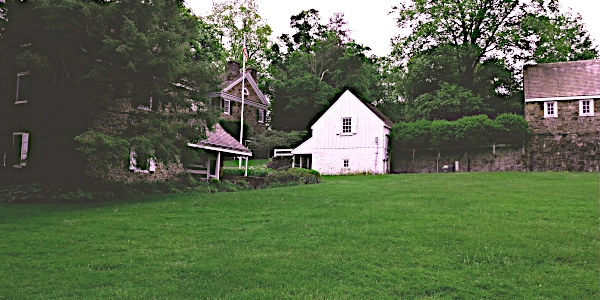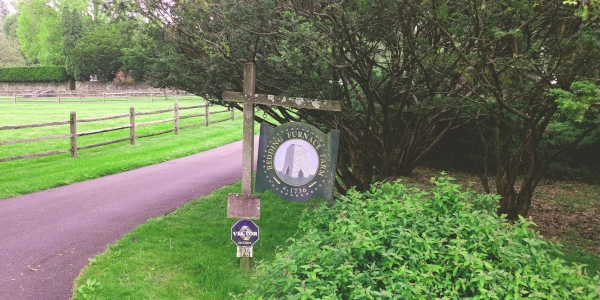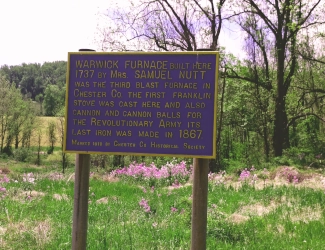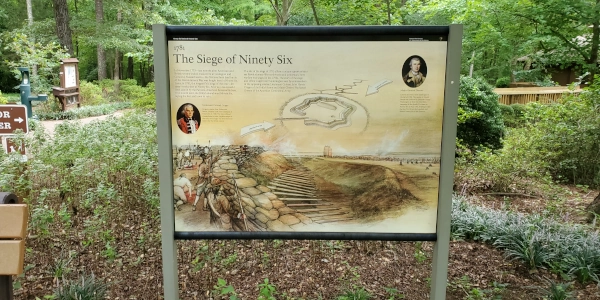
Image above: Waysides and remnants of Warwick Furnace, where Washington's Continental Army camped after losses at the Battle of Brandywine and the Battle of the Clouds, 2022, America's Best History.
Spotlight on Lesser Known History
Washington's Furnaces, Pennsylvania
America's Best History Spotlight
On this page we're going to Spotlight the lesser known historic sites and attractions that dot the history landscape across the USA and are worth a visit if you're in their area. And while they may be lesser known, some are very unique, and will be that rare find. You'll be, at times, on the ground floor, or maybe even know something others don't. It'll be fun. Visit them.

Washington's Furnaces, Pennsylvania
The furnaces fifty miles west of Philadelphia were imperative to keeping the Continental Army afloat after their defeats at the Battle of Brandywine and the Battle of the Clouds. So George Washington and the Continental Army fled to Warwick Furnaces and Reading Funaces where they could replace supplies, fix muskets, and provide a place to bury cannons if the British overtook Reading Furnace and Warwick Furnace, where Washington thought they were heading. Therefore, Washington was more concerned about his forges than he was in keeping the British from waltzing into Philadelphia and taking the capitol.
Image above: A closer view at the remnants of Warwick Furnace, 2022, America's Best History.
Sponsor this page for $100 per year. Your banner or text ad can fill the space above.
Click here to Sponsor the page and how to reserve your ad.
Info, What's There Now, History Nearby

Reading Furnace
Reading Furnace is located just five miles west of Warwick Furnace, and a portion of Washington's forces were housed there. He and his subordinates Alexander Hamilton, Lafayette, and others are reported to have eatern dinner here served by Thomas Bull's wife, former head of Warwick Furnace and then concurrently housed as a prison on a British ship in New York Harbor.
At some time during his stay, Washington learned that the troops he had left behind in the area of Malvern, General Anthony Wayne's force, about one quarter the strength of the Continental Army, had been massacred at Paoli at midnight. Their mission had been to keep track of where the British Army under Cornwallis, but had failed to post enough guards to warn of the attack. It was at this time he gathered his troops at both Reading Furnace and Warwick Furnace, heading east to meet with the wounded remnants of Wayne's contingent. They would eventually make camp at Camp Pottsgrove, between Sanatoga Hills and Frederick.
Warwick Furnace can be visited by the public. It houses waysides, trails, remnants of the furnace, signs about its role in the Civil War, and the original barns and house. The barns and house are privately owned, but protected.
Image above: The buildings of Reading Furnace, now private property, where some of the Continental Army camped, 2022, America's Best History Below: Sign on the private property of Reading Furnace today. Original buildings still remains as well as more modern buidings, 2022, America's Best History.

Where Are They?
Both furnaces are located about fifty miles west of Philadelphia off Route 23. Washington's route there had been up Route 23 through Phoenixville and just past Knauertown. There is a marker on the left side, at Warwick Furnace Road. Turn left there and continue on the road until reaching the parking lot of Warwick Furnace. There is a small parking lot and the property below the house is owned by the French Creek and Pickering Trust and is open to explore. The house and barn, which were part of the furnace, are private. Reading Furnace is best found by looking on your GPS or asking a local where it is. Not far, but a bit confusing to get there.
Minute Walk in History
What is There Now
Washington's Furnaces
Warwick Furnace, now known as the Thomas P. Bentley Nature Preserve, is open sunrise to sunset. There is a small parking lot, remnants of the original furnace, and many trails to walk. These are all on property owned by a preservation organization and can be explored. The original house and barns, with some additions, are original, but privately owned. Reading Furnace is private owned, well kept, and should be respected. Pictures from the farm road in front of the property is as far as you should go.
When Open and How Much
The grounds of Warwick Furnace are open year round. There is no charge.
Fees and hours are subject to change.
Websites
Thomas P. Bentley Nature Preserve
Reading Furnace Historic District
History Nearby
This is Philadelphia campaign of the American Revolution country at its furthest west. The main sites of the area include battlefields and Hopewell Furnace, which did not participate in the war, but is a wonderful National Park Service site to visit.
-
Valley Forge
-
Brandywine Battlefield
-
Battle of the Clouds
-
Paoli Massacre
-
Philadelphia and
Independence Hall
Buy Second Edition
America's Best History Timeline

Great book to keep your youngsters up to date on their history and prepared for that Spring Break interview by Jesse Watters or another man or woman on the street reporter.
Photos, History, and More Spotlights

The Controversy
For two hundred years, the park rangers at Valley Forge and other historians are tamped down the rumor that Washington buried his cannnons at the furnaces so they would not be confiscated by the British in case they came. You couldn't get them to even consider the possibility. Well, guess what, in 2022, four completely intact cannon were found in the field in front of the barn and house at Warwick Furnace. They have been restored and one sits in front of the furnace, protecting the site.
Photo above: House and barn at Warwick Furnace today. Cannons found several hundred yards to the left in the field across the road, 2022, America's Best History.

Other History at Warwick Furnace
Warwick Furnace had been unsed for munitions prior the the American Revolution and was the site of Benjamin Franklin building his first Frankling stove. It continued in use for the next one hundred years and forged cannon for the Civil War before it fell into disrepair. The uncovering of the walls of the furnace after the purchase by the French and Pickering Creeks Preservaton Site was one of their major projects.
The furnace was built in 1737 and purchased by the Trust in 2015. They now own 108 acres of land with three miles of trails and all that history. The Audubon Society also recognizes it as a significant birding area.
Photo above: Sign at Warwick Furnace, 2022, America's Best History.

The Cannon
Is there any more to say. Over two hundred years later, and her 4,500 pounds look good in the exhibit shelter. That's the one thing about history, there's always another discovery around the corner. And even when you are in the minority on a fact, it can still be true.
Photo above: Cannon in its exhibit shelter at Warwick Furnace, 2023, America's Best History.

T-Shirts and Gifts from the official souvenirs of Americasbesthistory.com.
About
America's Best History where we take a look at the timeline of American History and the historic sites and national parks that hold that history within their lands.
Photos courtesy of the Library of Congress, National Archives, National Park Service, americasbesthistory.com and its licensors.
- Contact Us
- About
- © 2022 Americasbesthistory.com.
Template by w3layouts.


